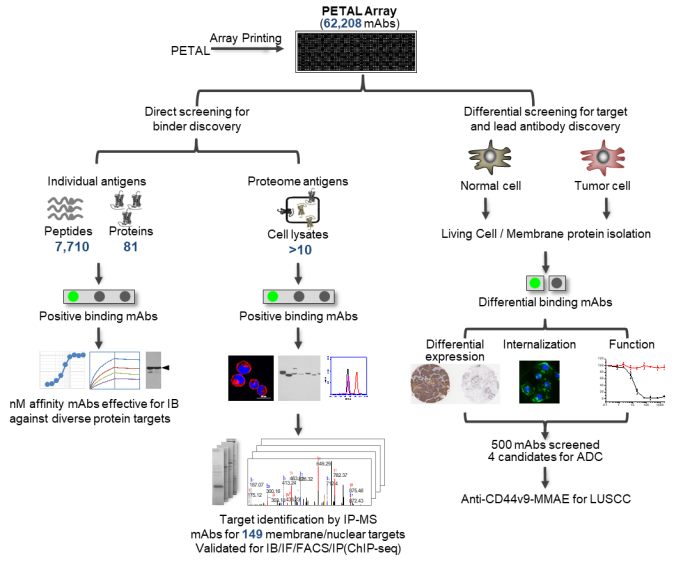
By combining the advantage of antibody multispecificity and high throughput screening ability of protein microarray, we developed the technology named PETAL (the Proteome Epitope Tag Antibody Library): 1) PETAL contains one of the world largest mouse monoclonal antibody library (current size >100,000 individual clones); 2) an antibody microarray screening platform enables rapid and high throughput antibody discovery for multitude antibody applications. PETAL had been successfully tested (but not limited) in antibody discovery for the following antigen types:
|
PETAL-peptide: in one of our project, 7,710 peptides from 3,600 proteins representing 470 proteomes were screened on PETAL array, 57% peptides obtained more than one antibody able to recognize <10 nM peptide antigen |

|
|
PETAL-protein: currently PETAL is able to obtain mAbs for about 25% input protein antigens, affinity ranged from nM to hundred nM. However the time and cost just a fraction of regular monoclonal antibody development, ie. for about $300 to obtain an antibody in one to two weeks. |

|
|
PETAL-proteome: proteomic or sub-proteomic samples may also be used to screen PETAL. In such way, hundreds of antibody-protein pairs would be acquired in several months. Therefore PETAL provides an affordable procedure for proteome-scale antibody generation, especially for model organisms that are in urgent needs of antibodies. |

|
|
PETAL-biomarker: differential screening by using proteomic samples of different phenotypes, PETAL is able to discover biomarkers for biological process and potential in diagnosis of human diseases. |
 |
|
PETAL-target: cells could also be an antigen type used to screen PETAL. For example, cells from human patients (ie. tumor) and normal persons (ie. papa-tumor tissue) could be compared on PETAL. The antibodies discovered in this way would bind to cell surface membrane proteins. Thus the binding target is potential to be a drugable target, and the antibody may be potential to be used in therapy as well. |
 |
